All published articles of this journal are available on ScienceDirect.
The Impact of AI-integrated Sport Blended Learning on Primary School Students' Sports Skills and Attitudes
Abstract
Introduction
This study examines the impact of AI-integrated Sport Blended Learning (AI-SBL) versus Traditional Face-To-Face Sport Learning (TFSL) on primary students' sport skills and attitudes. AI-integrated SBL provides personalized learning proven to enhance sports performance and PE engagement. We specifically investigate how AI-SBL enhances skills and promotes positive attitudes towards sports learning.
Methods
This study selected 94 students aged 8-9 years from Xinghu Primary School in Nantong City, Jiangsu Province. The subjects were divided into an experimental group (48 students) and a control group (46 students) using a computer-generated random allocation method. After confirming that there was no individual difference between the two groups through baseline data analysis, the experimental group implemented AI-integrated sport-blended learning teaching. In contrast, the control group conducted a comparative study using the traditional teaching method. Two Artificial Intelligence (AI) tools were used: Exercise Load Detection System (ELMS), which monitors exercise compliance via AI-driven tracking and feedback in PE classes. Daily Jump Rope App (DJR): A mobile app connecting in-class/after-class learning through real-time feedback, video tutorials, and fitness compensation. Sport skills (Vital capacity, 50-meter run, Sit-up-and-bend, 1-minute Jump rope) were analyzed via pre-post SBL data. Attitudes were assessed through four dimensions: sports attitude, learning purpose, learning time, and learning evaluation.
Results
AI-SBL significantly outperformed TFSL in skill development (all p<0.01; mean differences: Vital capacity = -1545, 50-meter run = 9.26, Sit-up-and-bend =13.37, 1-minute Jump rope = 141) and attitude improvement. Attitude analysis revealed consistently high evaluations: learning time (M = 4.27), sports attitude (M = 4.19), learning evaluation (M = 4.18), and learning purpose (M = 4.11), with SBL receiving more positive feedback.
Discussion
In physical education teaching, the AI-supported SBL model is significantly superior to TFSL in enhancing students' motor skills and learning attitudes. SBL integrates pre-class micro-videos, in-class ELMS, and DJR to achieve interaction between in-class and out-of-class activities. Its personalized and data-driven characteristics contrast sharply with traditional physical education teaching (TFSL). Empirical evidence shows that this model effectively improves the Vital capacity, 50-meter run, Sit-up-and-bend, and 1-minute Jump rope performance of primary school students. These skill advancements have further promoted a positive transformation in students' attitudes towards physical education, as evidenced by increased time investment and improved cognitive levels.
Conclusion
AI-SBL achieved superior sport performance and attitude outcomes compared to TFSL. This demonstrates AI-SBL's transformative potential in sports education methodology, providing valuable references for future research.
1. INTRODUCTION
1.1. Benefits, Dilemmas, and Risks of Using AI Technology
Artificial Intelligence (AI)-integrated sports learning acts as a “double-edged sword” [1]. Sports skill acquisition carries inherent risks of injury, ranging from minor to severe. Given the complexity of real-time risk assessment in dynamic athletic contexts, AI/ML-driven solutions show promise in three domains: injury prediction modeling, biomechanical performance analytics, and personalized training optimization [2]. Positive attitudes toward learning, including motivation, engagement, and persistence, are strongly linked to improved academic performance and the acquisition of essential life skills [3]. AI introduces transformative opportunities in physical education by revolutionizing traditional pedagogies and assessment systems. This study highlights its pivotal role in personalized learning and performance optimization through AI-driven analytics, thereby enhancing the precision of feedback for students. Key advancements include adaptive assessment frameworks, intelligent course recommendation engines, teacher competency development modules, and immersive classroom technologies [4]. In primary education, a critical phase shaping lifelong attitudes [5]. Positive learning dispositions (motivation, engagement, persistence) correlate with academic success and predict future cognitive competence [6, 7]. AI-driven tools, such as ELMS and sports apps, address these needs by optimizing teaching efficiency through real-time monitoring and boosting engagement via interactive personalization [3, 8, 9]. The emergence of these AI technologies can be an effective tool for PE teachers and students to support PE learning [10]. AI-enhanced wearables enable dynamic, personalized learning in physical education by delivering responsive and participatory experiences. This integration not only redefines pedagogical practices but also offers globally scalable solutions [11-13]. In his study, Fathoni (2018) pointed out that AI technology enhances the fun, contextualization, interaction, and real-time evaluation of traditional face-to-face sport learning (TFSL) in the classroom and after school, compared to traditional TFSL [14]. Xian (2010) specifically noted progressive improvements through blended learning updates [15].
1.2. AI Technology Alone is not Enough
Although AI technology has demonstrated significant potential to improve the quality of education, AI alone is not sufficient to meet the diverse needs of students in Primary school PE. Existing research suggests that the effectiveness of AI depends largely on the combination of instructional strategies that complement its functions [16, 17]. AI tools, while excellent at providing personalized feedback and tracking learning progress, often lack the ability to promote teamwork and social interaction, which are key elements in PE [18]. To address these limitations, the intervention proposed in this study combines AI-supported blended learning in sport with an experiential teaching approach. This blended model leverages AI-driven real-time data and adaptive learning experiences, while retaining the benefits of a human-centered approach to teaching and learning, particularly in areas such as collaboration, motivation, and skill development [19]. The significance of this study lies in creating a holistic learning environment that not only enhances motor skills but also fosters positive attitudes toward learning by simultaneously addressing cognitive and affective domains [20, 21]. By combining technology with evidence-based pedagogical practices, this study aims to bridge the gap between digital and traditional education and provide insights into the effective integration of AI in PE to maximize its impact on PE learning for Primary school students [22, 23].
In the above study, TFSL emphasizes the learning of sports skills but neglects the development of interests and habits, lacks flexibility in teaching content, and has a single teaching evaluation [24]. With the advancement of technology, AI is now being integrated into the SBL environment to provide more meaningful and authentic PE learning. The idea is to directly empower PE learning, both inside and outside the classroom, by combining AI and SBL. It is hypothesized that PE learning in AI in the SBL environment can improve Primary school students' sport skills and change their attitude towards PE learning. Therefore, this study proposes an AI-assisted SBL instructional model, and to evaluate the effectiveness of the proposed instructional model, the following three research questions are addressed:
- RQ1. How is AI-integrated sports blended learning that supports sports skills among primary school students developed?
- RQ2. Does AI-integrated sports blended learning effectively support sport skills among Primary school students?
- RQ3. What are students' attitudes toward AI-integrated sports-blended learning?
2. LITERATURE REVIEW
2.1. Correlation Definition Study
2.1.1. Artificial Intelligence
Artificial Intelligence (AI) is broadly defined as the simulation of human intelligence by a machine, enabling it to perform tasks such as learning, reasoning, and decision-making [25, 26]. In Primary school PE, AI has shown significant benefits, including increasing student engagement through gamification and contextualization, providing personalized feedback for skill development, and creating an immersive PE learning environment that meets individual needs [27]. For example, wearables, virtual technology, exercise apps, and AI-powered apps enable teachers to monitor students' physical activity in real-time, providing data-based adjustments that can improve cognition and body composition [15, 28]. The process of technology development in PE typically consists of several phases: a needs analysis to determine student and instructor requirements, an algorithm design to create a personalized learning model, integration of the tool into the curriculum, and an iterative evaluation based on feedback [12]. These steps ensure that AI technology can be effectively embedded in educational environments to maximize its transformative potential in Primary school PE learning [29, 30]. Similar definitions emphasize that the approach creates a more engaging and personalized learning experience by incorporating virtual tools such as wearables, gamified apps, and interactive feedback systems into actual physical activity [31]. In Primary school PE, blended learning in SBL offers a number of advantages, including increased student engagement, enhanced skill acquisition, and meeting diverse learning needs. For example, accurate monitoring of exercise loads through digital platforms and immersive gamification design can enhance students' motivation to learn. At the same time, AI-based feedback systems can provide personalized instruction to improve motor skills [32]. The process of developing blended learning in SBL typically involves several stages: identifying educational goals, integrating digital tools into the curriculum, designing interactive activities, and continually evaluating the program's effectiveness and engagement [33]. These steps ensure the effective implementation of blended learning in SBL, providing both cognitive and physical benefits to Primary school students [34].
2.1.2. Sport Skills
Sports skills are the abilities acquired by an individual through learning to perform physical activities effectively and efficiently, and are typically divided into basic sports skills and specialized skills required for specific sports (e.g., dribbling and passing in soccer) [35]. Related definitions emphasize the need for sport skills to integrate physical, cognitive, and behavioral components for success in sport and physical activity [36]. Developing sports skills in Primary school education has many benefits, including improving physical health, enhancing cognitive functioning, and promoting social skills such as teamwork and communication [37]. In addition, sports skills help increase students' self-confidence and self-efficacy, encouraging lifelong participation in sports [38]. Combined with technological tools, such as AI-based feedback systems and interactive platforms, this process can be further enhanced by providing personalized feedback, tracking progress, and increasing student engagement [39]. By integrating these steps, educators can ensure that students effectively acquire and apply sports skills for their overall development.
2.1.3. Sports Attitude
The sports learning attitude scale is composed of four aspects: (1) students' sports attitude, (2) sports learning purpose, (3) sports learning time, and (4) sports learning evaluation. The cognitive dimension encompasses beliefs and perceptions about the benefits of physical activity; the affective component involves preferences or aversions to physical activity, and the behavioral dimension reflects willingness to participate in or resistance to physical activity [40]. Yavuz (2019) stated that attitudes toward sport are key factors influencing sport participation and performance, and are influenced by a combination of personal experiences, social influences, and learning environments. For Primary school students, developing positive attitudes toward sport has many benefits, including increased participation, improved physical fitness, enhanced social interaction skills, and enhanced academic performance [41]. Positive attitudes toward sports also help students form lifelong habits of physical activity, which promotes overall health [40]. The development of attitudes toward sports typically involves several stages: exposure to fun and inclusive physical activity, reinforcement through positive experiences, and the development of intrinsic motivation through personalized and meaningful learning experiences [42]. The use of AI in PE further supports this process by providing personalized feedback, gamification elements, and adaptive learning environments to enhance student engagement and foster positive attitudes [43]. Through these steps, educators can effectively develop positive attitudes toward PE among Primary school students, thereby encouraging sustained physical activity participation.
2.1.4. Other Relevant Research
AI-integrated SBL can enhance students' sport skills and attitudes toward sport. The intervention first unfolds through a personalized feedback mechanism that uses AI-powered wearables and motion-tracking systems to analyze student movements and provide targeted suggestions for improvement [44]. Next, gamification using AI-based platforms creates engaging learning environments with points, rewards, and competitive elements that incentivize engagement and skill acquisition [45]. Collaborative activities are then introduced, and the AI system facilitates teamwork, peer learning, and cloud-based competitions by assigning roles and tracking team dynamics [46]. The SBL study demonstrated that these interventions significantly enhanced sport skills, cognitive understanding, and social interactions, while fostering positive attitudes toward PE [47]. In addition, AI integration enables continuous progress tracking to ensure a personalized and effective learning experience, as well as an after-school exercise platform that provides exercise prescriptions tailored to students' individual needs [48]. By focusing on both the physical and emotional domains, these interventions create a holistic learning environment that maximizes student development and engagement in PE.
2.2. Integrating Artificial Intelligence into Physical Education Teaching
Recent research on how AI-integrated SBL can enhance primary school students' sport skills and attitudes towards sport shows that this approach has significant potential. Existing research has explored a range of goals, including enhancing motor skills, fostering positive attitudes, and promoting inclusive learning environments [49]. Gamification elements in AI-enhanced platforms can significantly increase student motivation and engagement, leading to more positive attitudes toward PE courses. The latest interventions include AI-based wearables, motion analytics systems, and interactive platforms that are designed to provide adaptive, data-driven learning experiences. Iervolino et al. introduce an innovative approach in their study, based on existing research, which combines AI with a blended learning approach to provide a holistic intervention model [34]. Unlike previous studies, which typically focus on either skills or attitudes, the present study aims to develop a unified framework that simultaneously enhances sports skills and promotes positive attitudes towards sports. By filling this research gap, this study provides new insights into how AI can transform children's PE.
Cheng et al. [44] categorized this type of AI-integrated educational intervention into three phases: before, during, and after the lesson. In the pre-course phase, AI technologies, such as adaptive learning platforms and virtual simulations, were used to prepare students with foundational knowledge and basic sports skills, ensuring they were competent in real-world sports activities. AI-driven platforms analyze students (learning styles, interests, capabilities) to generate personalized training guidance [45]. After the class ended, the AI exercise app had already interfaced with the content taught in class, allowing students to target skill strengthening and physical fitness anytime, anywhere, without the constraints of time and space. This enabled performance analysis and personalized feedback, facilitating continuous learning and allowing students to review and consolidate skills [46]. Recent experiments have shown that these interventions significantly improve sports skills acquisition and foster positive attitudes toward sports among students by creating inclusive, precise, and adaptive learning environments [47]. The novelty of this study lies in its holistic approach, which integrates AI across all stages of learning and aims to improve both sport skills and sport attitudes. Unlike previous studies that mostly focused on a single aspect, this study attempts to update the model of blended learning in SBL and provide a new path for Primary school PE [13].
Therefore, this study aims to investigate further and understand the effects of the newly developed SBL teaching model on Primary school students' sport skills and attitudes towards sport. Fig. (1) shows the research model for this study.
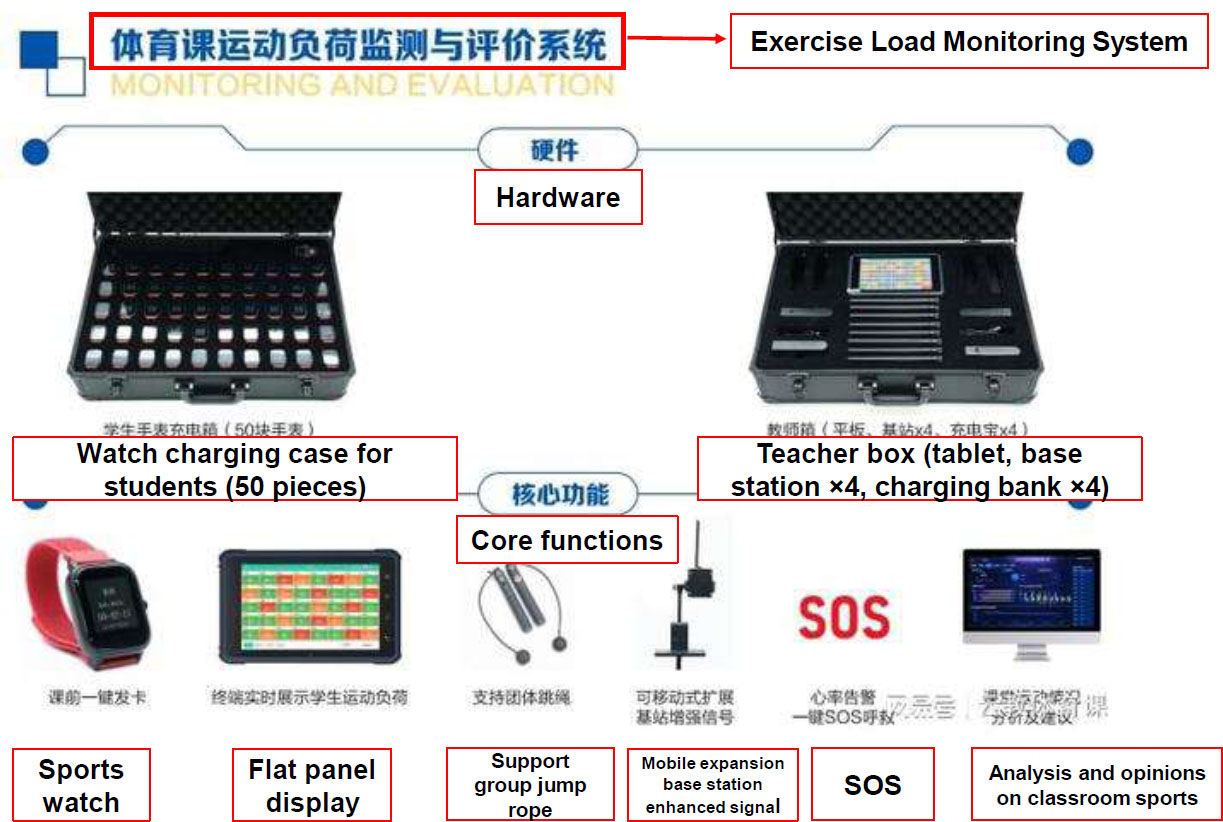
Hardware display diagram of exercise load monitoring system.
3. DEVELOPMENT OF THE SBL MODEL
3.1. AI Platforms
3.1.1. Exercise Load Detection System (ELMS)
ELMS is a sports load monitoring system developed by Shanghai Xianshi Education Technology Co., based on the National PE and Health Curriculum Standard 2022. The system is divided into two parts: hardware and core functions. The hardware consists of a student watch charger (50 pieces) and a teacher box. There are six core functions (Fig. 1).
In the classroom (Figs. 2 and 3), the teacher and students use the ELMS, and the students wear load watches on their wrists, which do not interfere with the PE movement. During class, the sports watches worn by the students are monitoring their physical exertion levels. Through the color blocks on the large screen, both students and teachers can see at any time the individual's physical exertion status. The primary purpose is to monitor students' heart rates in real-time during exercise. Taking a 9-year-old student as an example, the blue color block represents a low-intensity exercise state. At this time, the student's physical exertion is relatively small, and the heart rate is below 106 b/m; the green color block corresponds to a moderate-intensity exercise, and the student can better withstand the current exercise load, with the heart rate ranging from 106 to 148 b/m; the yellow color block indicates a moderately high-intensity exercise, and the student's body can receive good exercise, but it has not reached the limit state, with the heart rate ranging from 148 - 180 b/m; the red color block represents a high-intensity exercise. This suggests that teachers and students should monitor exercise intensity to prevent excessive fatigue or injury, especially when the heart rate exceeds 180 beats per minute. Students can view their exercise data on a large screen, which fosters self-motivation and enables them to track their progress. Teachers can use ELMS to obtain real-time data on students' exercise intensity, heart rate, pace, and other metrics. Before the lesson (Fig. 4), teachers use the exercise data collected by ELMS to review and analyze the exercise load in the classroom. The data from Fig. (4) reveals several key metrics. The classroom load achievement rate is 28.2%. The average heart rate is 117 beats per minute, which is far below the standard (140-160 beats per minute). Although the maximum heart rate is 146 beats per minute, it does not exceed the standard. The pass rate is 100%, and the duration of heart rate ≥ 120 beats per minute is 17′35″. Regarding exercise density, the group exercise density is 78%, the practice density is 58%, and the effective exercise density is 42%. All of these meet the standards, indicating that most students are qualified. However, despite the average calories (146) and the average heart rate index (156) being close to the standard, the number of qualified students is relatively small. The fluctuation of the heart rate curve of the class in the chart shows that the heart rate did not reach the ideal range for most of the time, the average heart rate in each stage was the highest but did not meet the standard either, and the distribution of exercise intensity was dominated by the 0 - 60% intensity range. Overall, the students' exercise load in this course is insufficient. Further adjustments to the teaching are needed to increase the intensity (This is a throwing distance course, and the students' heart rate is not easy to raise, which is the limitation of sports projects). Teachers also use the data (Fig. 5) provided by ELMS to discuss the relationship between exercise and health with their students.
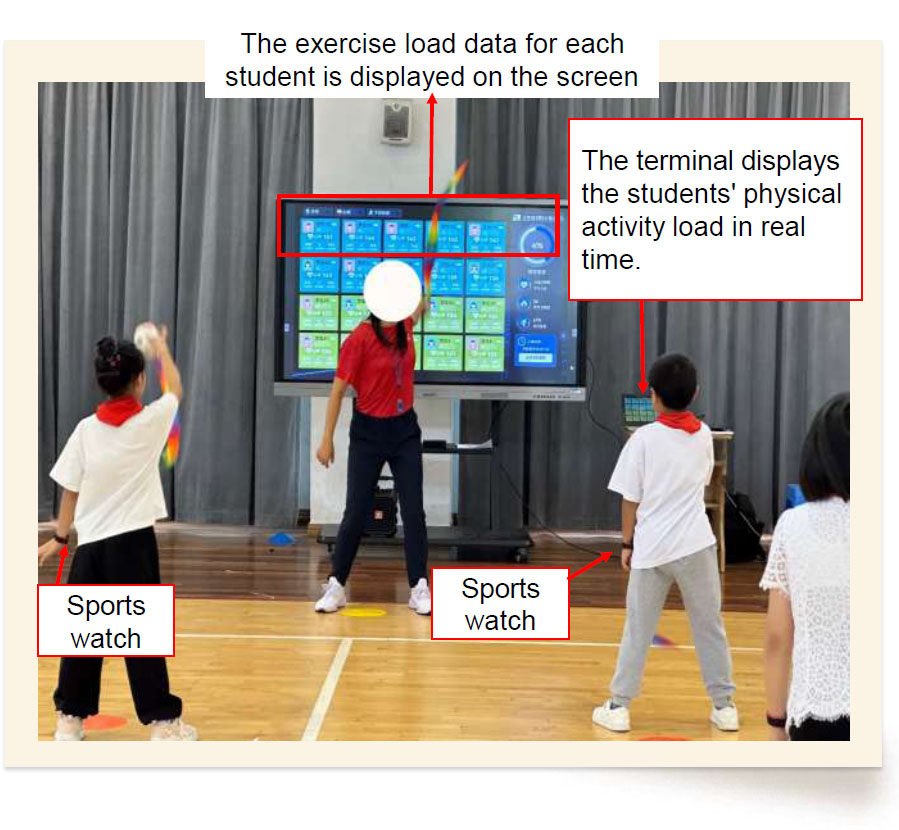
Teaching site of ELMS.
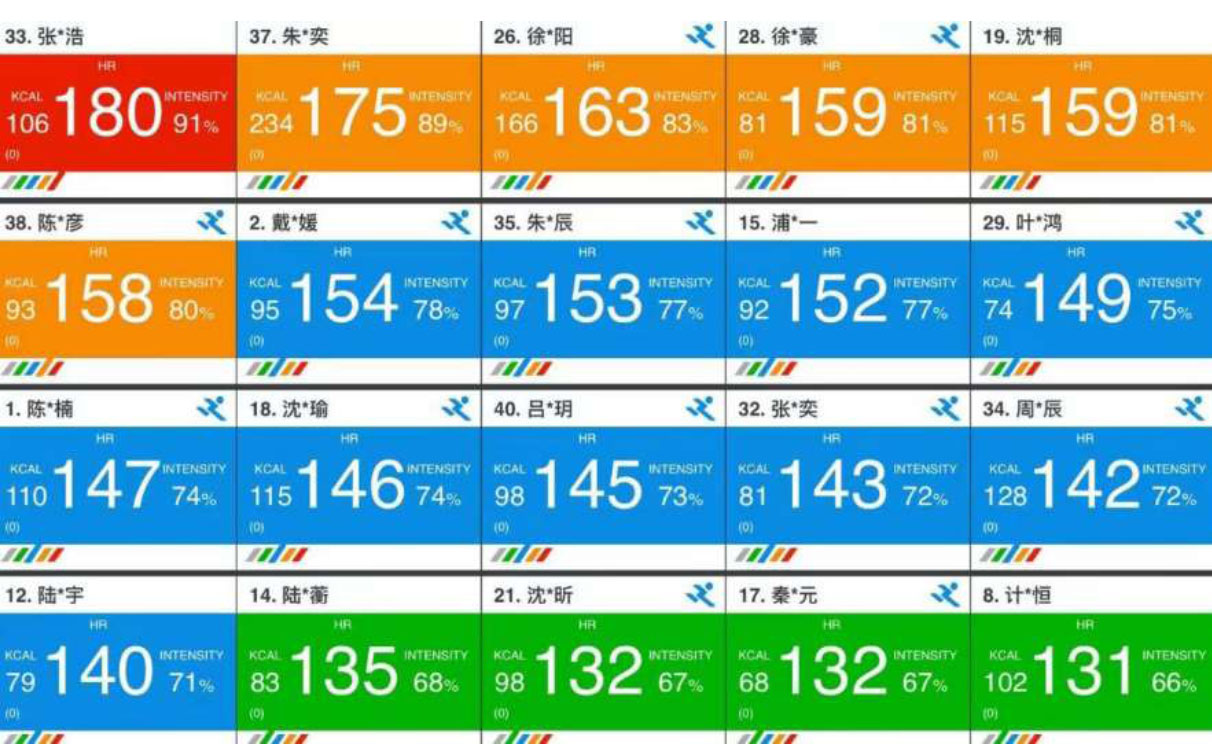
Real-time online monitoring of each student's heart rate.
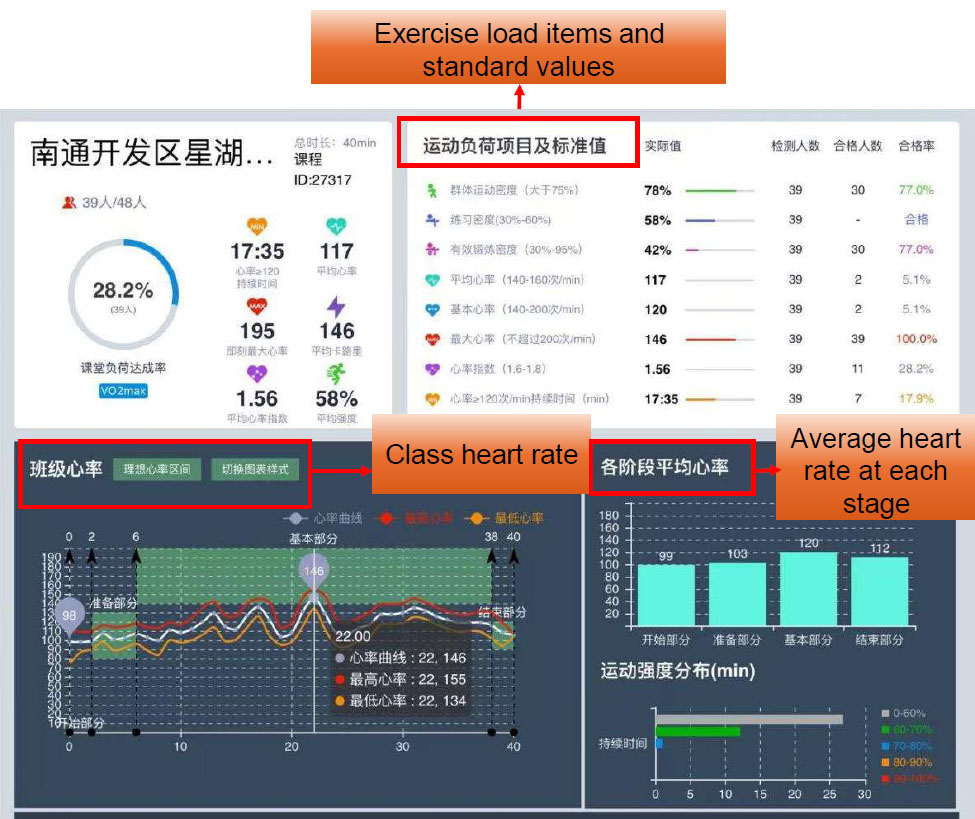
Analysis chart of exercise load results.

Heart rate graph of student “Chen XX” in PE class.
3.1.2. Daily Jump Rope App (DJR)
The Daily Jump Rope App was used to support sports learning before and after class, while the control group continued with traditional teaching methods. The DJR is an intelligent sports platform (Fig. 6), based on big data and algorithmic models, utilizing intelligent technology to calibrate human skeletal points, with a portrait recognition function combined with motion capture technology. In addition, the platform features AI interactive technology, including sports homework assignments, cloud competitions, and cloud physical testing, as well as a variety of combination sports and physically engaging activities. Furthermore, the DJR has an anti-cheating system and intelligent checking and correction of homework. The platform's video supervision effectively ensures that students participate and complete several exercises on a regular basis. The platform's intelligent homework correction function automatically generates a learning report for each exercise and creates visual icons of the overall class data, allowing teachers to see, at a glance, the completion status of students' homework. The intelligent supervision and data feedback function can effectively reduce the burden on teachers and parents.
3.2. Development of the AI-integrated SBL Model
3.2.1. Traditional Face-to-face Sport Learning (TFSL) Models
The TFSL model (Fig. 7) is centered on being teacher-led, with student participation, and typically includes teacher preparation, classroom instruction and demonstration, student practice, and on-site instruction by the teacher [29]. Teachers help students master motor skills through direct instruction and demonstration, and students improve their abilities through practice in the classroom and receive feedback and assessment from the teacher [44]. The model emphasizes the effective use of classroom time, with student learning primarily achieved through face-to-face interactions, and minimal post-class review is involved [45]. The core feature of TFSL is that teachers play a leading role, directly controlling classroom content and student activities.
Teaching usually focuses on the transfer of skills and practical operation.
3.2.2. AI-integrated Sports Blended Learning (SBL) Model
SBL teaching model after the experiment, including the process of teachers' and students' movement, AI technology-enabled PE learning in the three periods of time: before, during, and after the lesson (Fig. 8).
Before the lesson (Fig. 9), the teacher shares resources, collects information on students' learning conditions, presents problems that need to be solved during the lesson, assigns a PE teaching design, sets the course load for the lesson, and checks whether the students are wearing their watches. The students watch micro-videos related to the content being taught and complete the pre-study sheet. In class, teachers adjust the intensity and density of exercise in the classroom according to the intuitive interface statistical indicators and charts, and accurately provide personalized guidance (real-time monitoring and tracking of students' heart rate, intensity, density, participation rate, etc., in the class); students: according to the use of the ELMS in the PE classroom, can see their own real-time high and low levels of intensity of exercise (especially important to note that, when the exercise load exceeds the maximum value, the movement bracelet and the exercise bracelet system are able to detect students’ intensity of exercise and automatically send out an alarm to remind the instructor and the students of the need to adjust the amount and duration of exercise).
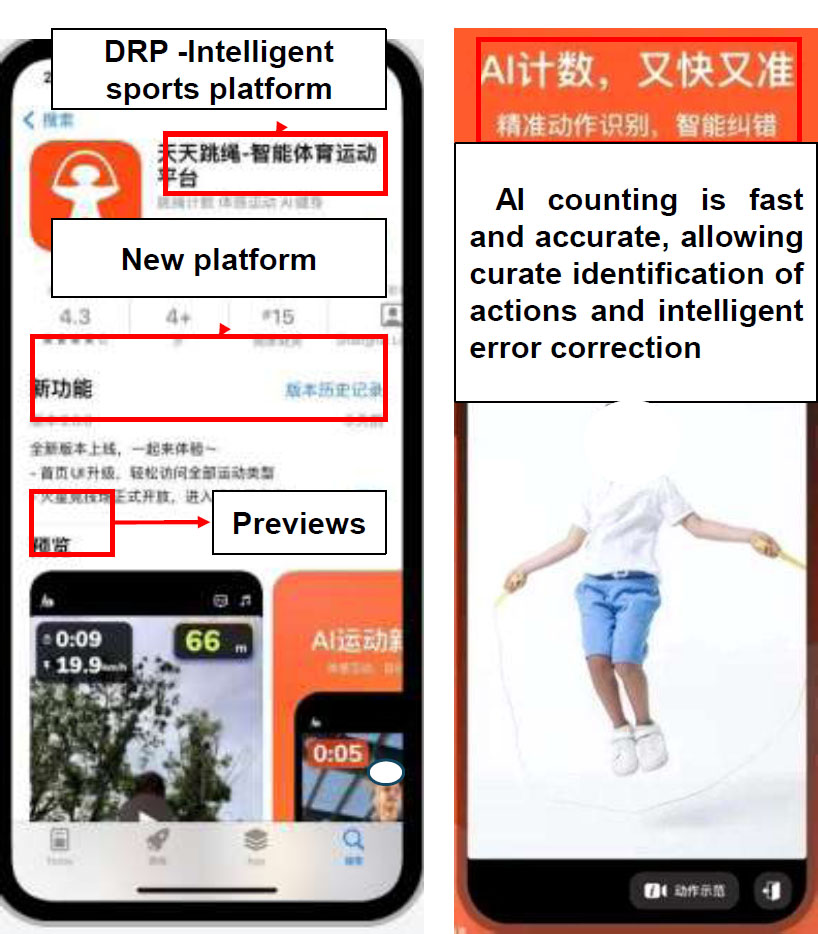
DJR platform.

TFSL model.
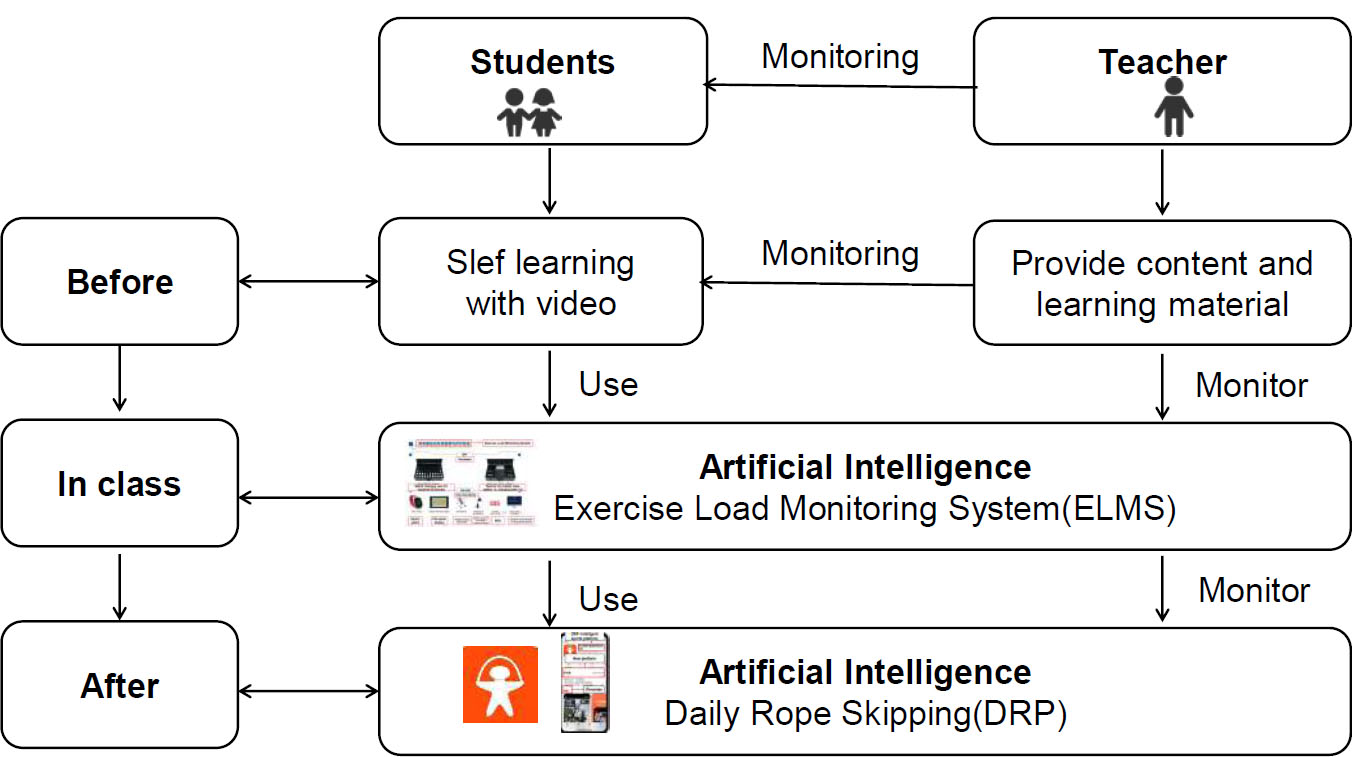
AI-integrated SBL model.
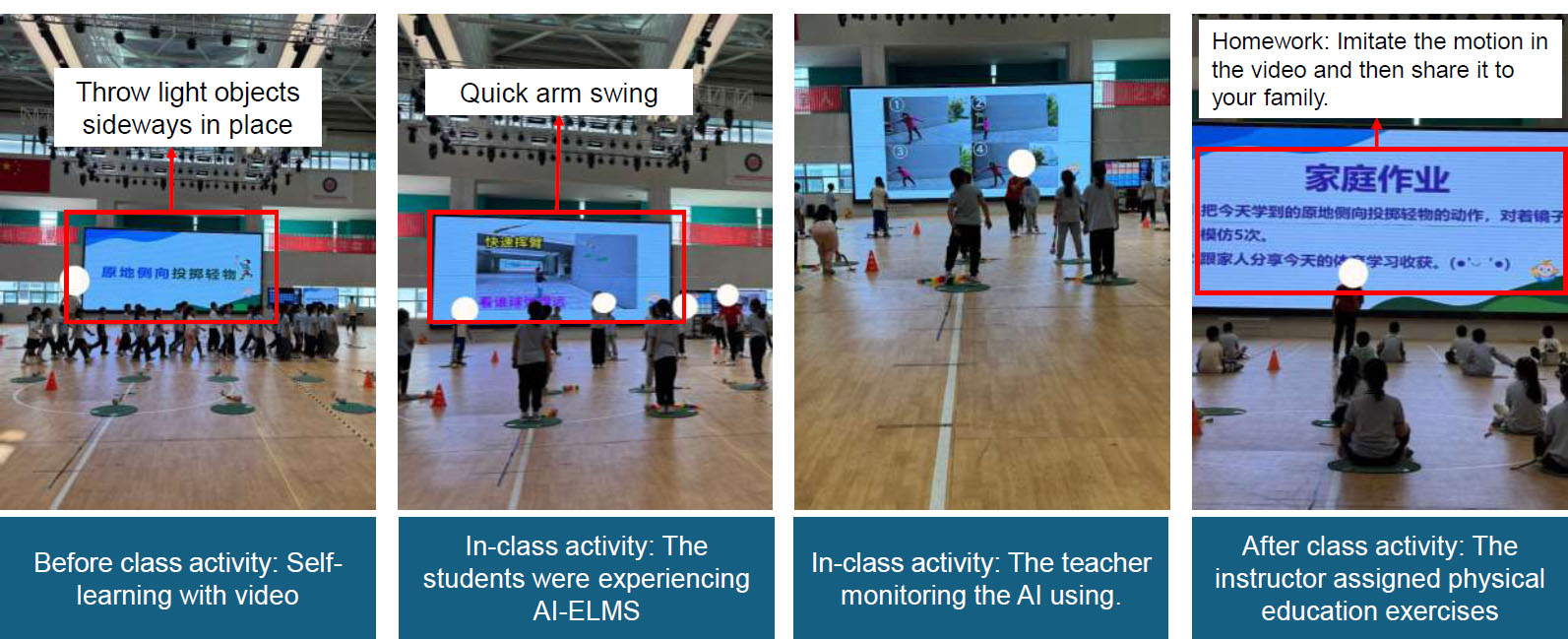
“The students experience AI-ELMS” (before class, in class).
After class (Fig. 10), the teacher processes and analyzes the data collected by the ELMS in the classroom (the system allows customized metrics to be used for various types of cross-sectional, longitudinal, and multidimensional analyses across classes, grades, school districts, and cities), conducts assessment of teaching effectiveness, researches teaching methods, identifies problems, and improves PE teaching, uses the DJR to post classroom-related exercise tasks for students to practice in a targeted manner after class. Students use the DJR to complete the exercise tasks issued by teachers. After completing these, they can then conduct independent exercise practice on the daily jump rope platform, based on their own exercise interests. DJR can provide real-time guidance and evaluation, which is superior to traditional face-to-face teaching. Additionally, there is no way to guide students' PE learning and practice outside of class. Such situational, personalized, precise, and efficient sports platforms can increase students' interest in sports, improve their attitudes towards sports, and enhance their sports skills.
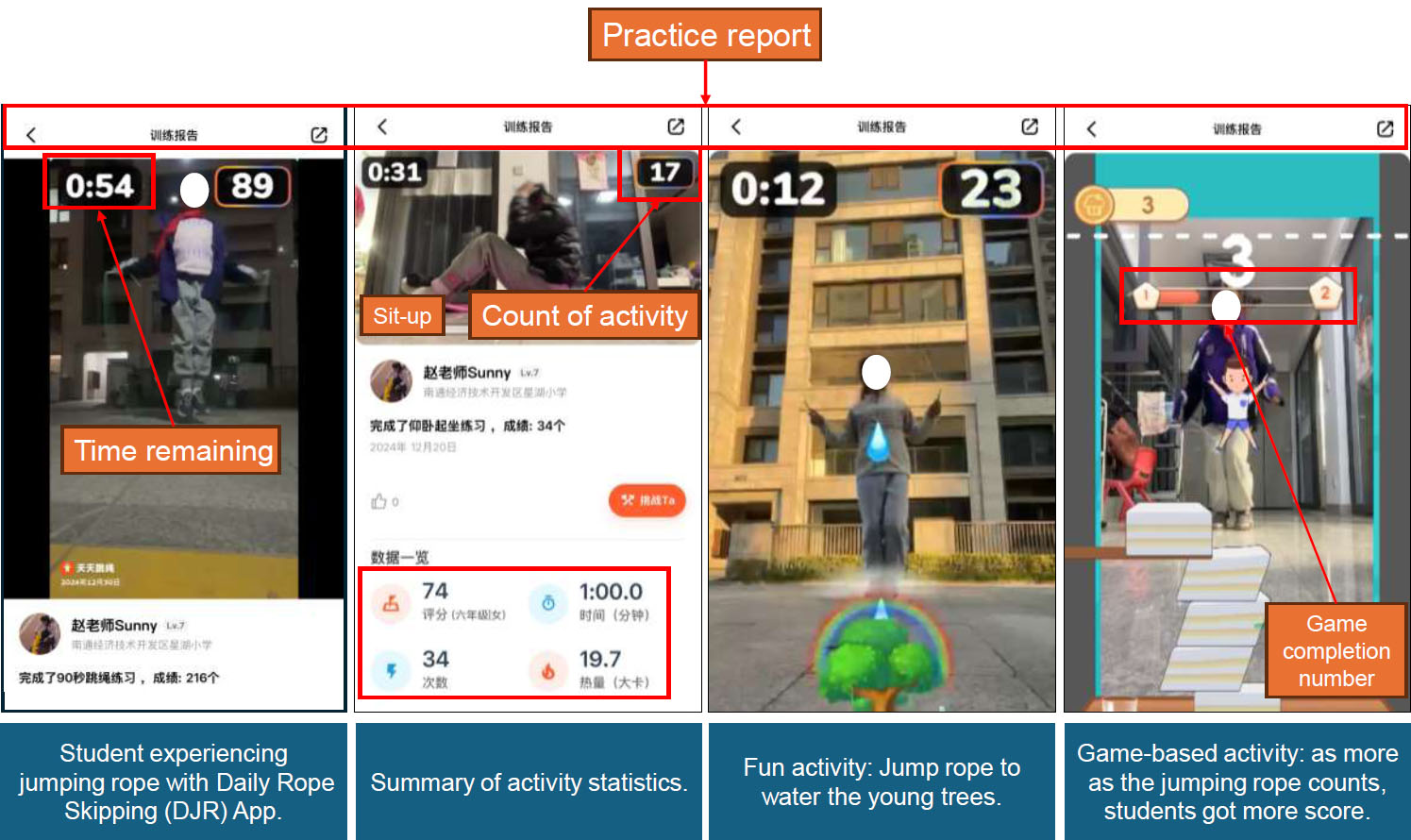
Student activities groups using ai-integrated SBL (after class).
4. METHODOLOGY
4.1. Participants
This was a quasi-experimental study, started from 01/09/2023 to 01/03/2025 in which the authors developed a PE teaching and learning research activity in AI-integrated SBL for the purpose of changing the PE learning styles of students in Xinghu Primary School in Nantong City (Grade 2, ages 8-9), Jiangsu Province, China. In PE intervention experiments (Table 1), where the hypothesized effect size is medium (Cohen's d≈0.5), a minimum of 60 students (30 students per group) is usually recommended to ensure the efficacy of the hypothesis test [48-50]. A census was used to select 94 students, who were subsequently randomized into two experimental groups using a computer-generated allocation sequence. All participants were divided into an experimental group (48 cases: boys' weight SD=3.69, girls' weight SD=3.72; boys' height SD=3.51, girls' height SD=3.63) and a control group (46 cases: boys' weight SD=3.96, girls' weight SD=3.78; boys' height SD=3.40, girls' height SD=3.48). Basic information was collected to ensure that there were no individual differences. Experimental Group 1 was taught using AI technology, while Control Group 2 was taught using traditional teaching methods.
4.2. Experimental Procedure
Fig. (11) illustrates the experimental activities of this study. The students were divided into two groups: an experimental group and a control group. Students in the experimental group were taught SBL using AI, while students in the control group were taught using TFSL lectures. The experimental and control groups were taught by the same teachers with the same PE program and content. Within 1-2 weeks, the teacher administered a data pre-test of “sports attitude” to the students using questionnaires, as well as data tests on four items: vital capacity, 50-meter run, Sit-up-and-bend, and 1-minute jump rope, before the experiments. Over a period of 3 to 12 weeks, the two groups of students began the experiment. The data analyzed the learning progress and content of the two student groups before, during, and after physical education classes. They collected the motor skills data after the tests were completed. At 13 weeks, the two groups of students received the post-test data from the “Sports Attitude” questionnaire and the corresponding post-test data from the four project experiments. In the 14th week, sort out and analyze the data and write the research report (Appendix A).
| No. | Demographic Aspects | Number Experiment | Control |
|---|---|---|---|
| 1 | Gender | - | - |
| Boys | 25 | 24 | |
| Girls | 23 | 22 | |
| 2 | Weight | - | - |
| Boys | x̄=28.73 (SD=3.69) | x̄=29.63(SD=3.96) | |
| Girls | x̄=28.13(SD=3.72) | x̄=28.92(SD=3.78) | |
| 3 | Height | - | - |
| Boys Girls |
x̄=131.13(SD=3.51) x̄=128.96(SD=3.63) | x̄=129.12(SD=3.40) x̄=130.25(SD=3.48) |
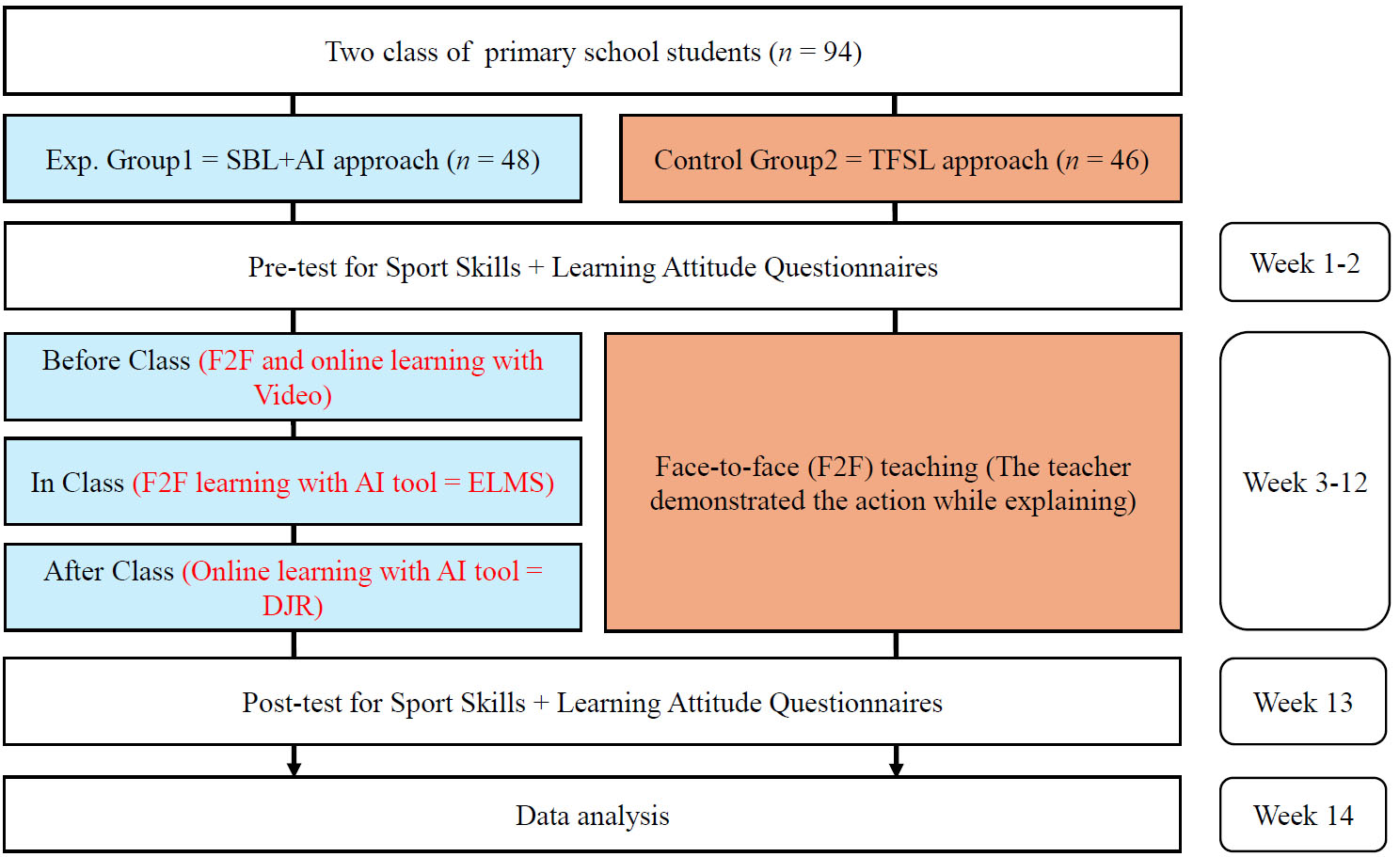
Flowchart of the design of the sports blended learning experiment.
4.3. Instruments
4.3.1. Student Sport Skills Test
To ensure authority and validity, all the pre-and post-test sport skills tests refer to the test requirements and standards of the 2014 Revised Edition of the Physical Fitness Standard for Chinese Students. The tests were administered simultaneously to 94 students at the same location, in the same test group, with the same test organization, encompassing a total of four test items: vital capacity, Sit-up-and-bend, 50-meter run, and 1-minute Jump rope. The results of the test items, according to the standards, were assessed as “excellent,” “good,” “qualified,” or “failed” (Appendix B).
4.3.2. Student Sports Learning Attitude Scale
The sports learning attitude scale was adapted from a study conducted by Wang et al. and consists of four dimensions: (1) students' Sports Attitude (SA), (2) Sports Learning Evaluation (SLE), (3) Sports Learning Time (SLT), and (4) Sports Learning Outcome (SLO) [51]. The scale consisted of more than 30 items. The reliability of this scale was demonstrated by a high Cronbach's alpha value of 0.869. The validity of the scale was further verified by factor analysis. This scale was also subjected to the same validity and reliability tests as in the first phase of the study. After collecting data on students' acquisition of sports skills, the students in the experimental group were given a questionnaire and asked open-ended questions about their perceptions of the learning activity. This covered a wide range of aspects relating to the participants' perceptions of the learning activities they received.
4.4. Data Analysis
The dependent variable of research question 2, sport skills, was analyzed using an independent samples T-test; the ANOVA results showed significant differences in the level of sport skills across each program, p < 0.05 (Table 2). To test the impact of the intervention and confirm that the SBL model with AI can promote the improvement of Primary school children's learning ability in sports, descriptive statistics were used to analyze the dependent variable of research question 3, sports attitudes. The intervention consisted of SBL with AI for the experimental group and TFSL for the control group, to assess its impact on students' attitudes toward PE learning. To explore the changes in students' attitudes toward PE learning, the researcher used measures such as mean, frequency, and percentage. Pre and post-experimental data were analyzed for the comparison group, and there was little variability in the basic information of the sample used in the experiment, but the small sample size and the size posed challenges, including data homogeneity, normality, and effect size [52]. Quantitative data were analyzed thematically for descriptive interpretation and analysis.
5. RESULTS
5.1. Development of AI-integrated SBL Teaching Model
This study explored AI-integrated SBL, which was found to significantly improve the sport learning skills and attitudes of Primary school students with significant differences compared to the learning outcomes of the traditional TFSL teaching model [13, 14, 53].
| Item | Group | n | x | SD | Levene’s Test | t | df | Sig. | Result | |
|---|---|---|---|---|---|---|---|---|---|---|
| F | Sig. | |||||||||
| Vital capacity | Exp1 Con2 |
48 46 |
1350 1050 |
75 65 |
0.16 | 0.75 | 47.42 | 92 | 0.000*** | Exp1>Con2 |
| 50-meter run | Exp1 Con2 |
48 46 |
9.26 12.51 |
0.74 1.01 |
6.54 | 0.01 | 17.71 | 92 | 0.000*** | Exp<Con2 |
| Sit-up-and-bend | Exp1 Con2 |
48 46 |
13.37 5.03 |
3.40 2.43 |
4.14 | 0.05 | 13.72 | 81.12 | 0.000*** | Exp1>Con2 |
| Jump rope | Exp1 Con2 |
48 46 |
141 97 |
23 16 |
3.40 | 0.07 | 10.54 | 92 | 0.000*** | Exp1>Con2 |
Among them, AI technology played a key role in updating the PE teaching model. From the perspective of the three phases—pre-course, in-course, and post-course—AI has promoted the reform and improvement of PE teaching in various aspects. During the pre-course phase, AI enables teachers to understand students' physical conditions, athletic abilities, and interests through data collection and analysis, allowing them to develop personalized instructional designs and lesson plans [54]. AI-powered learning platforms also automatically recommend appropriate learning content and training programs based on students' historical data and athletic performance to improve student engagement and learning outcomes [55, 56]. During the lesson, ELMS can accurately regulate students' exercise intensity, making teaching DJR more scientific and efficient compared to traditional methods. In the post-lesson phase, teachers optimize the teaching content by analyzing the sports load data, and students can also use it for targeted skills training and physical fitness [57]. The addition of AI promotes innovation in the SBL teaching mode, making sport teaching more interesting, precise, and efficient compared to TFSL.
5.2. Impact of SBL Teaching Model on Students' PE and Sport Skills
In this study, independent samples T-tests were used to compare the performance of the two groups in several tests of athletic ability.
- In the test of four sport skills (Table 2), Vital capacity Exp1x̄ = 1350, SD = 75, Con2x̄ = 1050, SD = 65, the mean lung capacity of Exp1 was 1350 ml with a standard deviation of 75. In contrast, the mean lung capacity of Con2 was 1050 mL with a standard deviation of 65 mL. The data showed that the experimental group's spirometry results were significantly higher than those of the control group, and the difference between the two groups was statistically significant (t = 47.42, p < 0.001), indicating that the exercise intervention had a significant effect on enhancing the students' spirometry.
- 50-meter run Exp1x̄= 9.26, SD= 0.74, Con2 x̄= 12.51, SD = 1.01. The results showed that the experimental group's running performance was significantly better than that of the control group, with a significant difference, t = 17.71, p < 0.001. This suggests that the sport skills intervention had a significant effect on improving the students' running performance.
- Sit-up and bend Exp1x̄ = 13.37, SD = 3.40, Con2 x̄ = 5.03, SD = 2.43. The results showed that the experimental group performed significantly better than the control group in this test, with a significant difference (t = 13.72, p < 0.001), suggesting that the exercise intervention had a significant impact on improving the students' flexibility.
- Jump rope, Exp1x̄= 141, SD= 23, Con2 x̄= 97, SD= 16. The experimental group performed significantly better than the control group, with a significant difference (t = 10.54, p < 0.001), indicating that the sport intervention significantly improved the coordination and endurance of the students.
The results of the four motor skill tests showed that Exp1 significantly outperformed Con2 in Vital capacity, the 50-meter run, Sit-Ups and bends, and the 1-minute Jump rope, and all differences reached statistical significance (p < 0.001). The Levene's Test results indicated that the chi-square values of the two groups were not significantly different in all the tests; therefore, the t-tests performed were valid.
5.3. Students' Sports Attitude toward the SBL Teaching Model
In the descriptive statistical analysis of students' attitudes toward SBL, the mean scores for all four dimensions were high (Table 3), indicating generally positive attitudes toward SBL. Specifically, the SLT group had a mean of M = 4.27 with a standard deviation of 0, indicating that the group was extremely consistent and that all students had nearly identical perceptions of SBL. The SA group M = 4.19, the SLE group M = 4.18, and the SLO group M = 4.11, and all these scores also reflected positive attitudes toward SBL, with small standard deviations (0.09, 0.01, 0.10, respectively), indicating that there were small differences in students' attitudes within each group. Overall, the results showed a high degree of consistency in attitudes across all groups, and all held a more positive view of SBL.
6. DISCUSSION
6.1. SBL Model vs TFSL Model
In the context of PE, the integration of AI with the SBL instructional model (Fig. 3) offers significant advantages over TFSL in terms of improving sports skills and student attitudes [30]. The SBL model utilizes a multidimensional approach to instruction, combining pre-class micro-video pushes, in-class ELMS, and DJR to connect classroom learning with out-of-class practice [57]. This personalized and data-driven approach to teaching and learning is significantly different from the traditional reliance on face-to-face static lectures [56, 58].
| - | Group | N | Mean | Std. Deviation |
|---|---|---|---|---|
| Score | SA | 48 | 4.19 | 0.09 |
| SLO | 48 | 4.11 | 0.10 | |
| SLT | 48 | 4.27 | 0 | |
| SLE | 48 | 4.18 | 0.01 |
6.1.1. Before Class
First, Pre-class send micro-video-enabled students to preview sports content (e.g., movement demonstrations, warm-up guidelines) via mobile apps, fostering engagement and autonomous learning through self-challenge opportunities [1, 15, 59]. Research has shown that multimedia learning, such as videos, can significantly enhance students' understanding of skills and concepts, thereby increasing the efficiency of actual practice [60]. In contrast, traditional teaching methods typically lack such pre-course preparation components, resulting in less efficient course execution [61].
6.1.2. In Class
Second, the in-class ELMS, as a core component of the SBL model of AI technology [26], is able to monitor students' physical loads in real-time, provide personalized feedback to students, and adjust the intensity of exercise according to their performance [60]. This system can avoid generalized feedback and make the learning process more refined, compared to traditional teaching methods [61, 62]. Research has shown that this real-time data-based feedback can improve learning outcomes by optimizing exercise intensity and duration [31, 58].
6.1.3. After Class
Finally, Post-class DJR implementation bridges classroom learning with extracurricular practice by recommending progress-aligned exercises and assigning targeted home workouts for skill consolidation [59, 63, 64]. Additionally, students can track their progress, receive personalized advice, and continue learning after school [62]. This fun and contextualized learning experience not only contributes to the continuous improvement of students' skills but also avoids the learning disconnect and lack of continuity that often occur at the end of class in TFSL instruction [65].
6.2. SBL Model under AI can Enhance Primary School Students' Sports Skills
The results also showed that the improvement of sports skills of Primary school students could be determined. There was a significant difference in the comparison of the Grade 2 Primary school students before and after the experiment. There was a significant difference (p < 0.05) between the PE performance of students in the experimental group, who used AI in SBL, and that of students in the control group, who used TFSL (Table 2). The AI-integrated SBL teaching model made significant progress in enhancing primary school students' sports skills by analyzing pre- and post-test data covering the four tests: Vital capacity, 50-meter run, Sit-up-and-bend, and 1-minute Jump rope. Comparison of the pre- and post-test data showed a significant improvement in students' performance in all four tests, reflecting the positive impact of the AI-integrated SBL model on enhancing students' physical fitness and motor skills. The integration of artificial intelligence into physical education courses has addressed the personalized gap in traditional teaching by systematically collecting sports learning data [35, 39, 66].
6.2.1. Vital Capacity
In terms of Vital capacity, the AI model adjusts the content of PE learning by monitoring students' exercise loads, allowing for real-time adjustments of exercise intensity during practice to enhance students' cardiorespiratory fitness [63]. It also collects data on exercise intensity over time to assign exercise prescriptions to each student. Research has shown that AI can optimize the training load and enhance students' physical health [31].
6.2.2. 50-meter Run
In the 50-meter sprint, the use of ELMS, combined with reviewing classroom videos, helped students monitor their exercise loads and adjust their running posture and stride, resulting in improved speed and agility [33]. Real-time performance tracking and feedback have been shown to improve students' sprinting performance [30].
6.2.3. Sit-up-and-bend
Students' flexibility also improved significantly during the Sit-up-and-bend test, indicating that, with the use of the DJR system under AI, and the monitoring of exercise data after class, the AI teacher was able to provide students with specific stretching exercises to help improve flexibility [59, 62].
6.2.4. 1-minute Jump Rope
In addition, in the 1-minute Jump rope test, the DJR system with AI can provide a fun, situational and immersive PE learning experience, provide instant guidance from the AI teacher and a rich library of exercise resources, drive students to actively learn and practice after class, buttress the classroom learning content, and consolidate learning and practice effects. AI intelligent technology keeps records, so that the movements used are collected, and real-time feedback can help students to improve their coordination and endurance [57, 60]. These results are consistent with previous research suggesting that personalized feedback and continuous practice play an important role in improving students' motor skills [1, 65].
In conclusion, the data suggest that the AI-integrated SBL instructional model significantly improves Primary school students' performance in various physical fitness tests, supporting the hypothesis that AI-driven personalized learning is more effective in enhancing students' sport skills than traditional teaching methods.
6.3. SBL Model with AI can Change Primary School Students' Attitude towards Learning PE
The SBL teaching model supported by AI has a significant impact on shaping Primary school students' attitudes towards PE. This can be derived from the pre- and post-test questionnaire data, which were conducted using a 5-point Likert scale, covering changes in Primary school students' attitudes towards PE programs, the purpose of PE learning, the time spent on PE learning, and the evaluation of PE learning.
6.3.1. Improvement in Primary School Students' Interest in PE Learning Attitudes
AI-integrated SBL enhances primary students' PE engagement through personalized learning and real-time feedback across pre-/in-/post-class phases [67]. By tailoring activities to individual capabilities, AI fosters autonomous motivation, transforming passive task completion into enjoyable challenges that reinforce the value perception of activities [37, 47, 68]. This approach enhances both skill acquisition and curricular identity, shifting student attitudes from compulsory participation to proactive involvement with sustained interest in sports [11, 69]. This change demonstrates that AI not only has a positive impact on skill enhancement but also plays a crucial role in increasing students' interest in sports and their long-term willingness to participate. This suggests that the AI-integrated SBL model can effectively stimulate students' interest in PE learning and change the lack of student interest in traditional PE [40, 70].
6.3.2. Primary School Students' Perception of the Purpose of PE Learning Changed
The perception of primary school students regarding the purpose of PE learning has also changed, and AI-supported PE learning emphasizes the development of lifelong sport skills and sustainable development [12]. The AI platform has enabled PE learning to be accessible anytime and anywhere, making it more scientific, intelligent, and modern. Primary school students participate in PE learning intuitively and with interest, transforming the experience from the tedious TFSL sport learning method. There is an emphasis on attending to each student's individualized development, as well as on diversified evaluation [71]. This shift helps Primary school students to have a broader and more positive perception of PE learning [37].
6.3.3. Primary School Students became more Committed to PE Learning Time
The integration of AI-integrated SBL instructional models helped students better understand the relevance and value of PE, motivating them to invest more time in both the classroom and extracurricular activities [58]. AI instruments, such as the before- and after-school DJR apps, made it easier for students to monitor their own progress, which further facilitated sustained attention to physical activity [62]. This finding is consistent with existing research, which shows that technology can enhance student engagement and sustain their interest in physical activity [40]. The quality of time spent in PE learning increased significantly from passive to active physical activity.
6.3.4. Primary School Students' Perceptions of PE Learning Assessment changed for the Better
The AI-integrated SBL instructional model also changed Primary school students' perceptions of PE learning assessment. Through continuous feedback and progress tracking, students' attitudes toward assessment became more positive and less anxious [57]. The ability of AI to provide objective, real-time assessment helped students to focus on improvement, rather than just results, thus fostering a growth mindset in PE [17, 59]. This is consistent with research suggesting that technology-based feedback systems can reduce the stress and practitioner workload associated with traditional assessments and encourage students to focus on personal development [18, 19]. In summary, this study demonstrates the transformative potential of AI-integrated SBL instructional models in primary school physical education. Through its tripartite framework (pre-class micro-learning, in-class ELMS monitoring, and post-class DJR reinforcement), the SBL model outperforms traditional TFSL methods in three critical dimensions:
6.3.4.1. Skill Enhancement
Quantitative data from four standardized fitness tests (Vital capacity, 50m sprint, Sit-up-and-bend, and Jump rope) revealed statistically significant improvements (p<0.05), attributable to AI-enabled personalized load adjustment, real-time biomechanical feedback, and data-driven exercise prescriptions.
6.3.4.2. Pedagogical Innovation
The seamless integration of mobile micro-videos, IT sensors, and intelligent recommendation systems addresses chronic limitations of conventional PE through contextualized learning, objective assessment, and sustained skill transfer beyond classroom settings.
6.3.4.3. Attitudinal Shift
Longitudinal tracking via Likert-scale surveys exposed fundamental transformations in learners' perceptions—from viewing PE as compulsory training to embracing it as an engaging, self-paced developmental process. Particularly noteworthy is the SBL model's success in fostering autonomous motivation through gamified challenges and progress visualization, effectively bridging the historical gap between physical skill acquisition and cognitive-emotional engagement in students' sports education. These findings provide empirical validation for AI's role in redefining 21st-century PE paradigms, suggesting its scalability across diverse educational contexts.
7. LIMITATIONS
There are several limitations to this study. First, AI-enabled PE is still in its infancy, and there are limitations to the choice of technologies that only presuppose the advantages that new technologies will bring. Second, the reliance on AI-powered instruments and technologies in blended learning in PE may not be realized equally in all educational settings, especially in underfunded schools, where the digital divide limits access to advanced technological infrastructure [23, 72]. Third, the implementation of AI tools in PE is often limited by a lack of teacher training, which may prevent the effective integration of these technologies into traditional teaching practices [73]. Fourth, another noteworthy limitation is the potential for data privacy issues, especially when collecting and processing sensitive fitness and behavioral data from young students, which can lead to ethical challenges if not properly managed [23]. Fifth, in addition, this study focused on Primary school Grade 2 students; the results may not be fully generalizable to other age groups, because students' developmental and cognitive needs vary widely [22]. Conducting a similar study in a more diverse PE setting, with a larger sample size, such as students with greater exposure to ELMS technology, may yield different results. Therefore, the author will expand the scope and sample size of the study population in subsequent studies [34].
CONCLUSION
The results of this study demonstrate that the SBL model with AI is superior to the TFSL model, indicating that AI technology enhances the teaching of PE and that the study's findings are statistically significant. In addition to this, the SBL model with AI can greatly contribute to improvements in the sport skills and attitudes of Primary school students. The SBL model with AI can have a significant impact on the learning interests, attitudes, and skills of students studying PE in Primary school. The use of ELMS during class and the DJR after class creates an engaging and interactive learning environment that improves Primary school students' attitudes and sports skills. Teachers can create an environment that encourages active PE learning, self-directed PE learning, and practicing inside and outside the classroom, and anytime, anywhere PE learning, by designing and implementing learning activities that incorporate the use of the SBL model with AI. As a result, Primary school students become more interested and motivated to learn sportss skills, which improves their attitudes toward learning sports and developing skills. In conclusion, physical educators can create a dynamic and effective learning environment that transforms PE by supporting Primary school students' PE learning through the SBL with the AI model and by providing them with an AI-immersive PE learning experience.
To summarize, the SBL teaching model with AI is superior to the TFSL face-to-face sport learning model with Primary school students, and through the experimental method and questionnaire survey method, it is verified that there is a significant difference between Primary school students in terms of their learning skills and attitudes. These tests proved that AI-empowered PE learning, curriculum innovation, and foresight in PE.
PEDAGOGICAL IMPLICATIONS
AI-integrated SBL demonstrates transformative pedagogical value by synergizing personalized skill development with attitudinal engagement in primary physical education. Real-time feedback and biometric monitoring (e.g., exercise intensity/recovery analytics) enable the refinement of scientific skills while fostering metacognitive awareness of physical development [18, 17]. This tailored interactivity counteracts traditional PE's engagement deficits by aligning tasks with individual competencies, thereby converting passive participation into goal-driven mastery experiences [19, 20, 23].
Moreover, AI's continuous support ecosystem (in-class guidance to post-class tracking) cultivates sustained motivation, evidenced by elevated self-efficacy and proactive attitudes toward lifelong physical activity. The blended learning model builds a scaffold for physical education teaching through the establishment of three stages: pre-class physical education knowledge construction, in-class skill refinement, and post-class self-study and practice, thereby enhancing the efficiency of physical education teaching. This model promotes the paradigm shift from the standardized learning framework to the multimodal learning framework [35, 39, 74]. Such integration aligns with modern educational paradigms prioritizing adaptive inclusivity, positioning AI-driven SBL as a catalyst for holistic PE modernization that concurrently advances motor competencies and intrinsic behavioral commitment.
AUTHORS’ CONTRIBUTIONS
It is hereby acknowledged that all authors have accepted responsibility for the manuscript's content and consented to its submission. They have meticulously reviewed all results and unanimously approved the final version of the manuscript.
LIST OF ABBREVIATIONS
| AI | = Artificial Intelligence |
| SBL | = Sports Blended Learning |
| TFSL | = Traditional face-to-face Sport Learning |
| ELMS | = Exercise Load Monitoring System |
| DJR | = Daily Jump Rope Application |
| PE | = Physical Education |
| F2F | = Face to Face |
ETHICS APPROVAL AND CONSENT TO PARTICIPATE
The study was conducted according to the compulsory education “Physical Education and Health Curriculum Standards” designated by the Ministry of Education of the People's Republic of China, and approved by the Scientific Research Ethics Committee of the Economic and Technological Development Zone of Nantong, Jiangsu Province, China (No:2024-06).
HUMAN AND ANIMAL RIGHTS
All human research procedures followed were in accordance with the ethical standards of the committee responsible for human experimentation (institutional and national), and with the Helsinki Declaration of 1975, as revised in 2013.
CONSENT FOR PUBLICATION
Informed consent was obtained from all subjects (or their guardians) involved in the study.
AVAILABILITY OF DATA AND MATERIALS
The data and supportive information available within the article.
ACKNOWLEDGEMENTS
Declared none.
APPENDIX A
| Likert 5-level Scale | 1=Strongly Disagree | 2=Disagree | 3=Neutral | 4=Agree | 5=Strongly Agree |
|---|---|---|---|---|---|
|
Sport Attitude 1. I like taking part in sports activities. 2. I think the PE class is interesting. 3. I found that using AI technology in PE class helped me better understand sports skills. 4. I like to use AI tools (like apps or activity trackers) to track my physical activity performance. 5. I think AI technology makes PE more interesting and interactive. 6. I think sports activities can make me feel relaxed and happy. |
|||||
|
Sport Learning Objectives 1. I think PE class can help me build up my strength and health. 2. The main purpose of my PE class is to improve my sports skills. 3. In PE class, the feedback provided by AI motivated me to improve my sports skills. 4. I take a PE class to exercise my body.. 5. I believe AI technology can improve sports skills. |
|||||
|
Sport Learning Time 1. I am willing to spend more time participating in extra-curricular sports activities to improve my athletic ability. |
|||||
|
Sport Learning Evaluation 1. I use AI-powered apps to practice sports skills outside of class, which helps me improve faster. 2. I think sports skills evaluation should not only assess the performance in the game, but also take into account the process and effort. |
|||||
APPENDIX B
| National physical fitness standards for primary school students of china (revised in 2014). | |||||
|---|---|---|---|---|---|
| Grade 2 | |||||
| Boy | |||||
| Level | Score | 50-meter run | Sit-up-and-bend | 1-minute Jump rope | Vital capacity |
| Excellent | 100 | 9.6 | 16.2 | 117 | 2000 |
| 95 | 9.7 | 14.7 | 112 | 1900 | |
| 90 | 9.8 | 13.2 | 107 | 1800 | |
| Good | 85 | 9.9 | 11.9 | 101 | 1650 |
| 80 | 10.0 | 10.6 | 95 | 1500 | |
| Pass | 78 | 10.2 | 9.5 | 88 | 1430 |
| 76 | 10.4 | 8.4 | 81 | 1360 | |
| 74 | 10.6 | 7.3 | 74 | 1290 | |
| 72 | 10.8 | 6.2 | 67 | 1220 | |
| 70 | 11.0 | 5. 1 | 60 | 1150 | |
| 68 | 11.2 | 4.0 | 53 | 1080 | |
| 66 | 11.4 | 2.9 | 46 | 1010 | |
| 64 | 11.6 | 1.8 | 39 | 940 | |
| 62 | 11.8 | 0.7 | 32 | 870 | |
| 60 | 12.0 | -0.4 | 25 | 800 | |
| Fail | 50 | 12.2 | - 1.2 | 22 | 750 |
| 40 | 12.4 | -2.0 | 19 | 700 | |
| 30 | 12.6 | -2.8 | 16 | 650 | |
| 20 | 12.8 | -3.6 | 13 | 600 | |
| 10 | 13.0 | -4.4 | 10 | 550 | |
| 0 | 20.0 | -30.0 | 0 | 0 | |
| Level | Score | 50-meter run | Sit-up-and-bend | 1-minute Jump rope | Vital capacity |
|---|---|---|---|---|---|
| Excellent | 100 | 10.0 | 18.9 | 127 | 1600 |
| 95 | 10. 1 | 17.6 | 120 | 1500 | |
| 90 | 10.2 | 16.3 | 113 | 1400 | |
| Good | 85 | 10.5 | 14.8 | 105 | 1300 |
| 80 | 10.8 | 13.3 | 97 | 1200 | |
| Pass | 78 | 11.0 | 12.2 | 90 | 1150 |
| 76 | 11.2 | 1 1. 1 | 83 | 1100 | |
| 74 | 11.4 | 10.0 | 76 | 1050 | |
| 72 | 11.6 | 8.9 | 69 | 1000 | |
| 70 | 11.8 | 7.8 | 62 | 950 | |
| 68 | 12.0 | 6.7 | 55 | 900 | |
| 66 | 12.2 | 5.6 | 48 | 850 | |
| 64 | 12.4 | 4.5 | 41 | 800 | |
| 62 | 12.6 | 3.4 | 34 | 750 | |
| 62 | 12.8 | 2.3 | 27 | 700 | |
| Fail | 50 | 13.0 | 1.5 | 24 | 680 |
| 40 | 13.2 | 0.7 | 21 | 660 | |
| 30 | 13.4 | -0. 1 | 18 | 640 | |
| 20 | 13.6 | -0.9 | 15 | 620 | |
| 10 | 13.8 | - 1.7 | 12 | 600 | |
| 0 | 20.0 | -30.0 | 0 | 0 |


